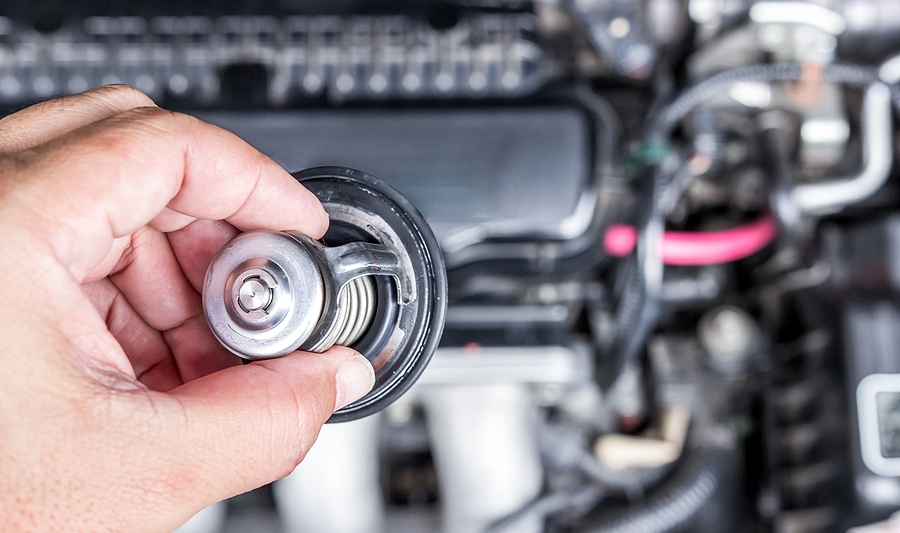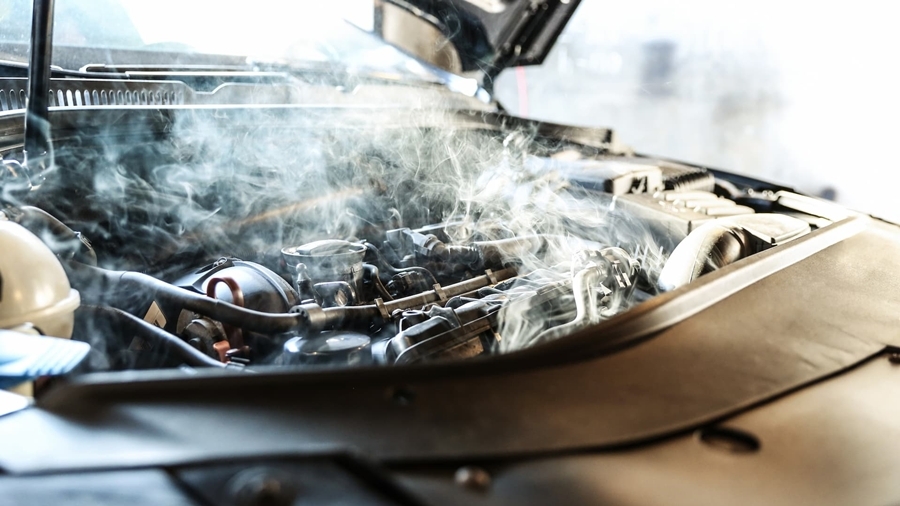Keeping an eye on your car’s cooling system is super important for protecting your engine. If you have a rad fluid leak and you don’t catch it, you could be in for some serious trouble. It’s really helpful to know how to spot, figure out, and fix this issue so you can dodge expensive repairs and keep your car running smoothly.
Table of Contents
Look out for signs like dropping coolant levels, puddles or stains under your car, or if your engine’s overheating. Make sure to check hoses and connections for any wear and tear, since a rad fluid leak often happens there. Plus, sticking to a regular schedule for swapping out coolant and flushing the system can really help your cooling system last longer and perform better.
Being proactive not only helps your car last longer but also keeps you safer on the road. A good cooling system keeps your engine at the right temperature, preventing overheating that could wreck your engine. Regular maintenance checks can also catch other issues early, like a bad thermostat or a water pump that’s on the fritz, which could make cooling problems worse if ignored. By putting a little time into these preventive steps, you’ll have a more reliable ride and lower the chances of unexpected breakdowns.
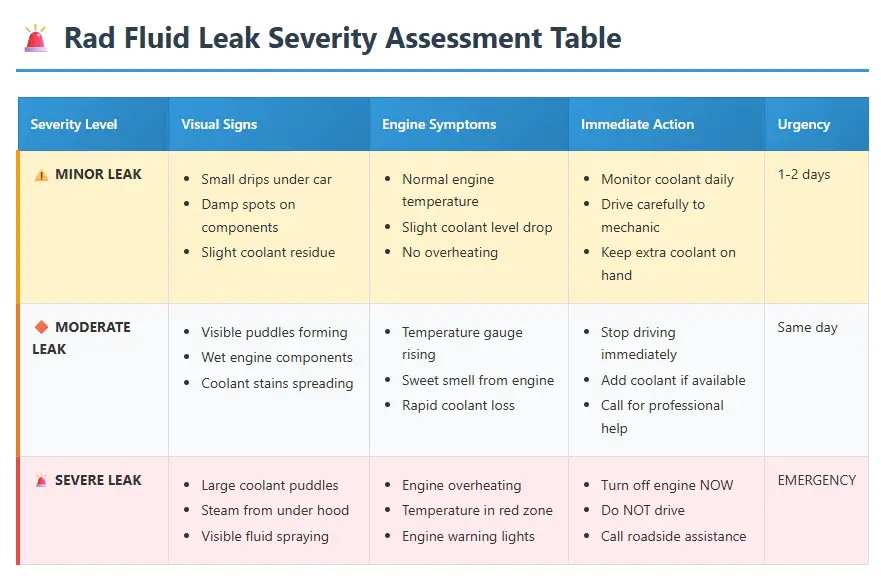
Introduction
Radiator fluid, also known as coolant or antifreeze, plays a vital role in keeping your engine cool. When there’s a rad fluid leak in the radiator system, it can spell trouble. Leaking coolant can lead to engine overheating, reduced efficiency, and even severe engine damage. Failing to address a rad fluid leak can compromise your safety and shorten your vehicle’s lifespan. Acting quickly when you notice signs of leakage makes a difference.
In addition to overheating, a coolant leak can also affect other critical components of your vehicle, such as the water pump and heater core. The water pump relies on coolant to maintain its functionality, and a lack of fluid can lead to pump failure, resulting in costly repairs. Furthermore, the heater core, which provides warmth to the cabin, can also become compromised if coolant levels drop too low. A rad fluid leak can impact these systems significantly. Regularly checking coolant levels and inspecting for signs of a rad fluid leak can help prevent these issues, ensuring that your vehicle remains in optimal condition.
Also read: PROVEN 5-Step Guide to Fix Dangerous Coolant Leaks Inside Your Engine
What Is Car Radiator Fluid and Why Is It Essential?
Understanding Radiator Fluid (Coolant)
Coolant is basically a blend of water and stuff like antifreeze. It flows through your engine, soaking up heat and keeping things from getting too hot. Plus, it stops the water from freezing when it’s chilly outside and helps keep rust and corrosion out of the radiator. You can either buy coolant that’s already mixed or mix water with antifreeze concentrate, depending on what your car needs. When you have a rad fluid leak, this essential mixture can’t do its job properly.
How Radiator Fluid Circulates
Think of the cooling system as your engine’s bloodstream. The water pump moves coolant through the engine block and the radiator. As the coolant picks up heat, it heads to the radiator to cool off before looping back to the engine. The main components are the radiator, water pump, thermostat, hoses, and radiator cap. Keeping everything flowing smoothly ensures the engine stays at the right temperature. However, a rad fluid leak anywhere in this system can disrupt the entire circulation process.

Recognizing the Signs of a Rad Fluid Leak
1. Visible Radiator Leak Symptoms
If you notice puddles or spots under your parked car, that’s a pretty good sign of a rad fluid leak. These usually show up as wet, slimy marks under the front or sides. You might also spot some residue on engine parts, which can mean there’s a leak happening, especially around hoses or the radiator. And if you catch a whiff of a sweet, syrupy smell near the engine bay, that’s another clue pointing to a potential rad fluid leak.
2. Engine and Performance Indicators
If your engine’s running hotter than normal, take a look at the temperature gauge—overheating’s a big warning sign of a rad fluid leak. If you see steam coming from under the hood, it means you’re losing coolant. You might also catch a whiff of a sweet smell when the coolant burns or turns to vapor. Don’t ignore these signs, or you could end up with major engine problems from an untreated rad fluid leak.
3. Other Signs to Watch For
Keep an eye on the coolant level in your reservoir. If it suddenly drops, you might have a leak. Plus, if your car’s heater isn’t warming up or is blowing cold air, the coolant might not be circulating right. These are hints that your cooling system might be acting up due to a rad fluid leak.
Also read: 8 Critical Engine Coolant Colors
Common Causes of Car Radiator Fluid Leak
1. Physical Damage to Radiator or Hoses
Road debris can hit and crack or puncture your radiator or hoses, leading to a rad fluid leak. As cars get older, rust and corrosion can weaken the metal and cause leaks. Over time, parts can become brittle and more likely to crack. Regular driving can make these issues worse, especially if your car is on the older side, increasing the chances of developing a rad fluid leak.
2. Faulty Radiator Cap or Pressure System
If your radiator cap isn’t working properly, it can’t keep the right pressure, which lets coolant leak out and creates a rad fluid leak situation. The pressure system is supposed to keep the coolant in when things heat up. But if it doesn’t do its job, you might see leaks around the cap or inside the radiator.
3. Leaking Water Pump or Thermostat Housing
If the seal fails, coolant can drip into these areas, causing a rad fluid leak. The water pump’s job is to keep the coolant moving, so if it leaks, there’s less coolant in the system. Likewise, if there are cracks in the thermostat housing, coolant can leak out, which messes with the engine temperature and signals a potential rad fluid leak.
4. Clamp and Fitting Failures
If hose clamps are loose or corroded, they can cause slow leaks that develop into a more serious rad fluid leak. Fittings might get loose over time, especially with all the vibrations from driving. Putting everything together right and checking things regularly can stop these small problems from turning into bigger leaks.

What Color is the Coolant/Antifreeze?
1. Green Coolant
Green coolant is the old-school favorite. It’s a hit because it’s cheap and lasts a while. But watch out—if it starts looking brown or murky, it might be getting old or contaminated.
If you spot green coolant leaking, it could mean there’s rust in the radiator or a hose has split, indicating a rad fluid leak. It’s probably time for a coolant change or a system check. So, if you see bright green puddles under your car, get it looked at.
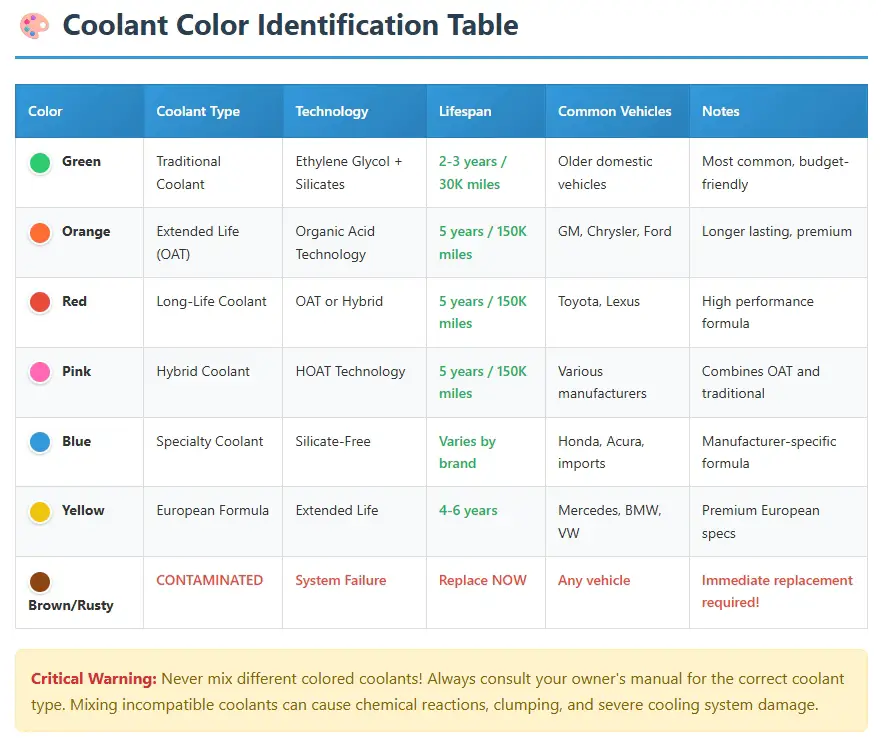
2. Orange, Red, Pink Coolant
Lots of newer cars go for orange, red, or pink coolants, which are the long-lasting or hybrid types. They can stick around for up to 5 years or 150,000 miles.
Spotting a leak with orange or red coolant might mean it’s broken down or mixed with other stuff, suggesting a rad fluid leak. It could also point to incompatible coolants or a seal issue. Keep an eye on these colors, especially if you’ve just changed or topped up the coolant.
3. Blue and Yellow Coolant
Blue and yellow coolants aren’t as common, but they’re used in certain vehicles or brands. They’re usually silicate-free and made for specific engines.
If you see blue or yellow coolant leaking, it might be because of a special additive mix, which could indicate a rad fluid leak. This needs special attention since mixing different coolants can cause clumps and make them less effective. If you notice these colors leaking, have a pro check it out.
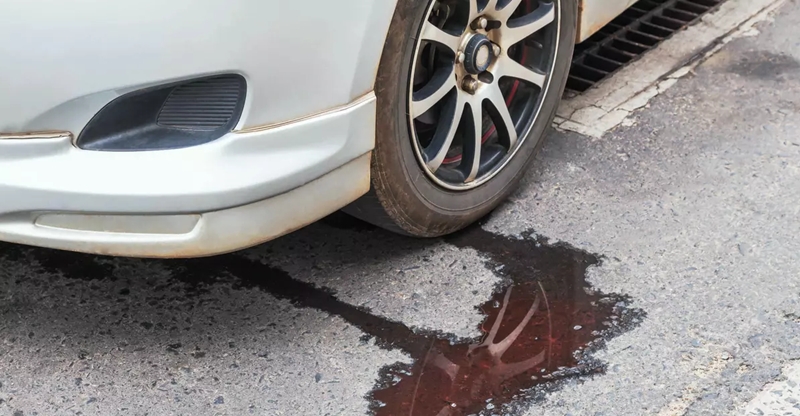
Diagnosing a Car Radiator Fluid Leak
1. Visual Inspection Techniques
Check under your vehicle—look for puddles or wet spots that indicate a rad fluid leak. Open the hood and inspect hoses, clamps, and radiator seams. Look for cracks, corrosion, or blistered paint that signals a leak. Use a flashlight to identify tiny leaks not easily seen and confirm whether you have a rad fluid leak.
2. Using Pressure Tests
A radiator pressure test involves attaching a special tool that pressurizes the cooling system. If the pressure drops or you see bubbles or leaks, it’s time for repairs and confirms a rad fluid leak. Performing this test can uncover hidden leaks inside the radiator or hoses that might not be visible during a standard inspection.
3. Checking for Internal Cooling System Issues
Internal leaks happen when coolant escapes into the engine, not outside, creating a different type of rad fluid leak. Signs include overheating despite a full reservoir or milky oil deposits. Professional diagnostics are often necessary to find internal problems and avoid serious damage from this type of rad fluid leak.
Repairing and Addressing a Radiator Coolant Fluid Leak
When to Repair vs. Replace Your Radiator
Small leaks from hoses or clamps are often repairable with simple fixes. Larger cracks or corrosion usually require replacement when dealing with a significant rad fluid leak. Weigh the cost of repairs against the benefits of a new radiator or part. Sometimes, replacement is more reliable than trying to patch a persistent rad fluid leak.
DIY Repair Tips
For temporary fixes, use radiator sealant—just follow the instructions to address a minor rad fluid leak. To fix hoses, tighten or replace clamps. Repairing a radiator leak or replacing hoses can be a manageable DIY project if you have basic tools. Always let the engine cool before starting repairs on any rad fluid leak.
Professional Repair and Maintenance
Complex leaks need a mechanic’s touch to properly diagnose and fix a rad fluid leak. Experts can identify leak sources precisely. Regular coolant flushes and system checks help prevent leaks from forming. Invest in professional maintenance to extend your cooling system’s life and avoid future rad fluid leak issues.
Preventative Measures
Make routine inspections part of your schedule—check coolant levels monthly to catch any early signs of a rad fluid leak. Flush the radiator every 2-3 years to remove debris. Avoid rough driving and road hazards that can damage radiator parts. Small upkeep prevents big problems later.
Need a mechanic? Find one on the Mobile Mechanic Directory
Risks and Consequences of Ignoring a Radiator Fluid Leak
If you ignore a rad fluid leak, your engine might overheat, which can mess up engine parts or even lead to a complete engine breakdown. Fixing this can be super expensive, often costing thousands. Plus, coolant leaks are bad for the environment because the fluids are toxic. Taking care of a rad fluid leak early on can save you money and keep your ride safer.
Cost of Fixing a Radiator Coolant Fluid Leak
DIY Repair Costs
If you’re handy, fixing it yourself can save you money. Swapping out a hose might set you back $20-$50, while a new radiator could cost between $100 and $300. You’ll need some tools like wrenches and a drain pan. Overall, doing it yourself can cost anywhere from $50 to $300, depending on what needs fixing.
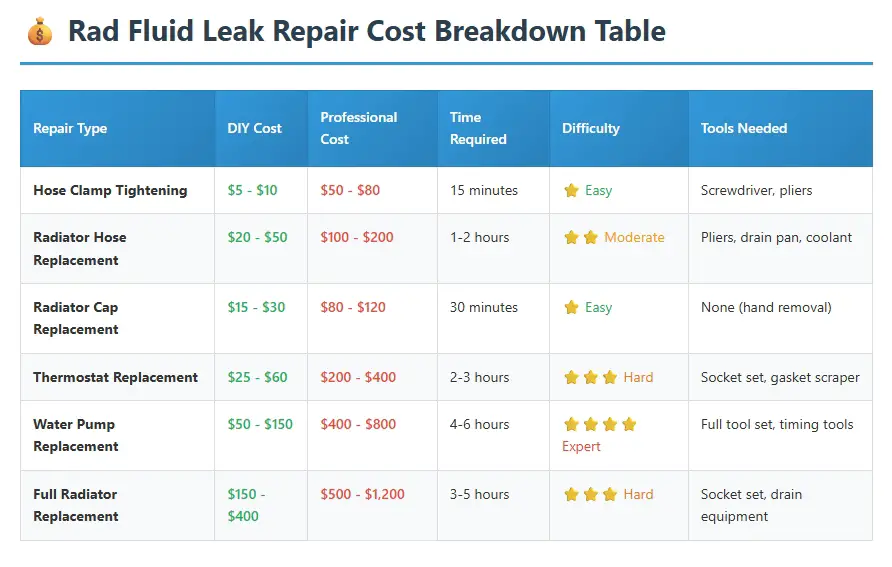
Professional Repair Costs
Going to a pro means paying for parts and labor. Fixing a hose might run you $100-$200, and getting a new radiator could be $300 to $800 or more. Prices can change based on where you live. More complicated fixes, like system flushes or changing the thermostat, will add to the cost.
Extra Costs to Think About
Don’t forget about other expenses like diagnostic fees ($50-$100) and new coolant ($20-$50). If your car overheats, you might need emergency repairs or towing. Keeping up with regular maintenance, like flushes or changing the coolant, can help you avoid bigger bills down the road.

FAQ: Rad Fluid Leak
What is a rad fluid leak and how serious is it?
A rad fluid leak occurs when coolant escapes from your car’s cooling system through cracks, damaged hoses, or faulty components. It’s very serious because it can lead to engine overheating, costly repairs, and complete engine failure if left untreated.
How can I tell if I have a rad fluid leak?
ommon signs include puddles of colored fluid under your parked car, dropping coolant levels, engine overheating, steam from under the hood, and a sweet smell near the engine bay. You may also notice poor cabin heating performance.
What causes a rad fluid leak in cars?
The most common causes include physical damage to the radiator or hoses from road debris, faulty radiator caps, worn water pump seals, corroded clamps and fittings, and age-related deterioration of cooling system components.
Can I drive with a radiator fluid leak?
It’s not recommended to drive with a rad fluid leak as it can cause severe engine damage from overheating. If you must drive, keep trips short, monitor the temperature gauge closely, and add coolant as needed until you can get professional repairs.
How much does it cost to fix a rad fluid leak?
Repair costs vary depending on the source and severity. Simple hose replacements may cost $50-150, while radiator repairs can range from $300-800. Complete radiator replacement can cost $500-1,200 including labor.
Can I fix a radiator fluid leak myself?
Minor leaks from loose clamps or small hose cracks can often be DIY repairs. However, complex issues like internal leaks, radiator damage, or water pump problems typically require professional diagnosis and repair for safety and reliability.
How do I prevent coolant leaks?
Regular maintenance is key: check coolant levels monthly, flush the cooling system every 2-3 years, inspect hoses and clamps for wear, avoid rough driving conditions, and address any cooling system issues promptly before they worsen.
What color should my coolant be, and does it matter for leaks?
Coolant comes in various colors (green, orange, red, pink, blue, yellow) depending on the type and brand. The color can help identify the source and age of a coolant leak, but any colored fluid leaking from your car’s cooling system requires immediate attention.
Final Thoughts
Radiator fluid leaks happen more often than you’d expect and can lead to big problems if you ignore them. Watch out for signs like puddles under your car, overheating, or a sweet smell. These leaks usually come from things like damaged hoses, cracks in the radiator, or bad caps. Spotting and fixing these issues quickly is the best way to avoid expensive engine problems.
Regular check-ups, fixing things on time, and good maintenance help keep your cooling system in good shape. Remember, taking care of your radiator now helps your car in the long run. Stay alert and keep your engine cool—your ride relies on it.




